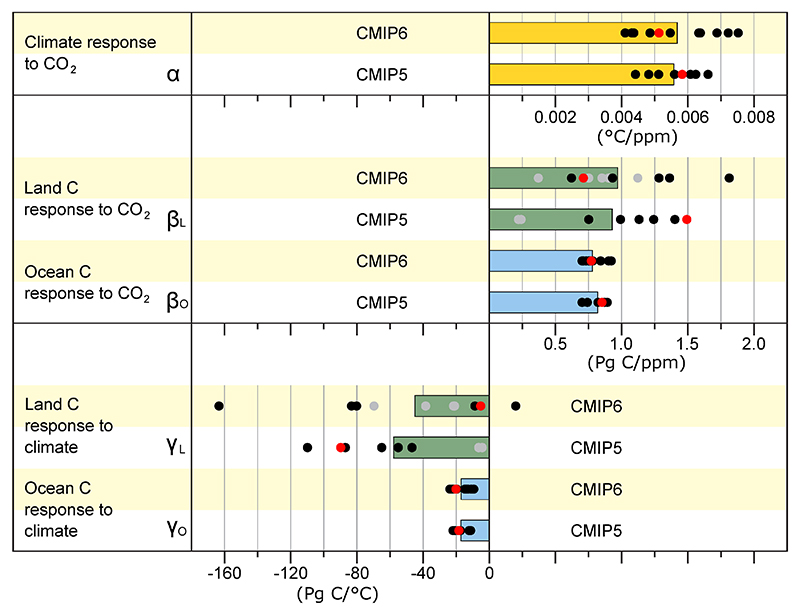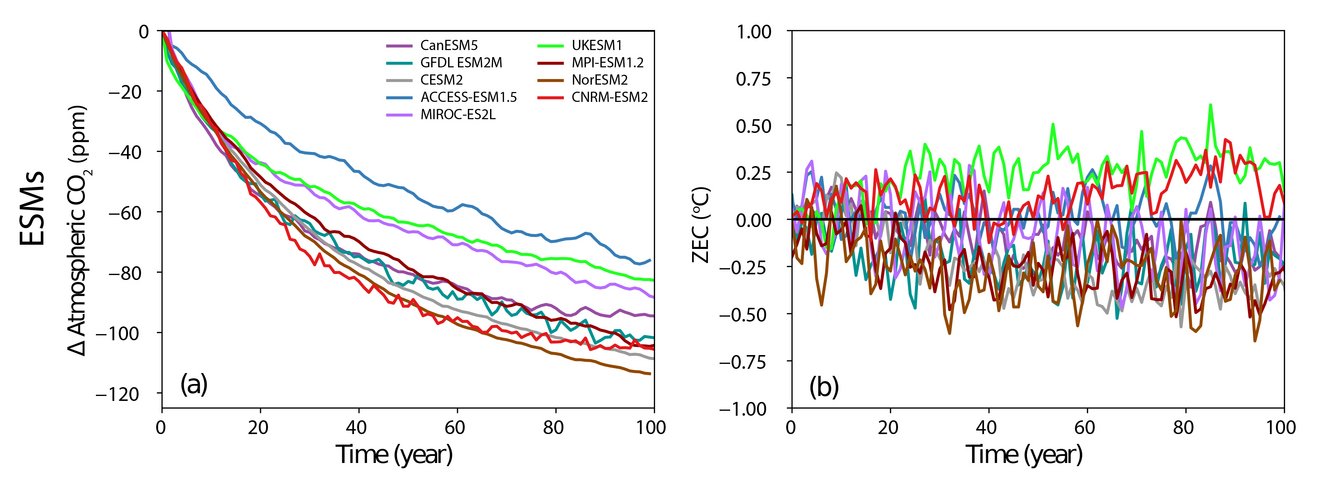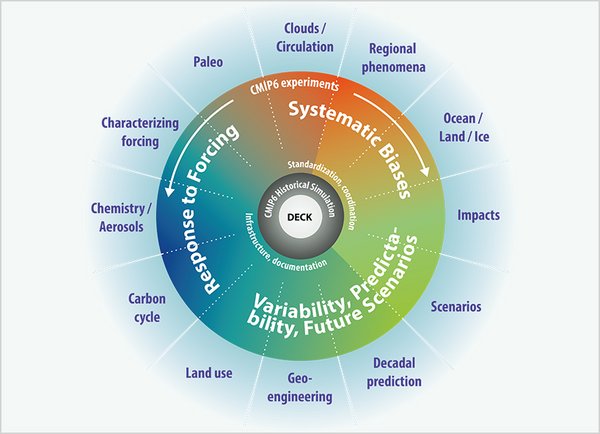Smaller land carbon feedback in the new MPI Earth System Model
Carbon dioxide is the main forcing of anthropogenic climate change. Since the pre-industrial period, more than a half of anthropogenic carbon emissions were taken up by land ecosystems or dissolved in the ocean. What are main drivers of the carbon uptake and will this natural service continue in the future? After all, the strength of our required mitigation efforts will depend directly on the size of these sinks. The researchers divided the feedback between climate and carbon cycle into two components: effect of warming on carbon uptake (carbon-climate feedback) and effect of growing CO2 on carbon uptake (carbon-CO2 feedback). Both effects are pronounced for land and ocean processes, and uncertainties in the land feedbacks are much higher than for the ocean, as shown also in the previous intercomparison, CMIP5 (Fig. 1). This is because the chemical reactions driving the dissolution of CO2 in seawater are more consistently represented in the models as opposed to the biological processes on land.
Innovations in CMIP6
Since CMIP5, scientists have invested heavily into modelling new processes on land such as wildfires and nitrogen-carbon coupling. The carbon-nitrogen coupling generally leads to reduced land carbon sensitivity. Dr. Thomas Raddatz comments: “As a part of the new MPI-M Earth system model (MPI-ESM), the land surface component JSBACH brings in a strong set of changes: novel land processes such as nutrient cycling plus new models for soil carbon and wildfires. As a result, JSBACH shows in CMIP6 a much smaller sensitivity of land carbon storage to increasing atmospheric CO2 and temperatures compared to CMIP5.” Prof. Julia Pongratz continues: “In this new version of the MPI-ESM, we have substantially improved the representation of soil carbon dynamics, for example, we added that plant growth is also limited by nitrogen availability. Overall, our updates led to a substantial reduction in the feedback of the carbon cycle to climate, i.e. though warming generally leads to a loss of carbon from the soil, because microbes are more active, less CO2 is outgassed from the global soils in the new model version. Since CO2 is a greenhouse gas, the additional warming, the "feedback" between climate and the carbon cycle, appears less strong than in the earlier model version. Other processes must thus have contributed more to historical warming.”

Cessation of CO2 emissions and temperature changes
In the novel set of experiments, an international team of scientists use emission-driven CMIP6 models to evaluate climate and CO2 dynamics after a complete cease of CO2 emissions, the so-called zero-emission commitment (MacDougall et al, 2020). After a complete stop of emissions, thermal inertia, which would drive the temperature up, is compensated by decreasing atmospheric CO2 due to land and ocean carbon uptake (Fig. 2, left). These two factors operate differently in different models, but on average the models show no global temperature increase after emissions cease (Fig. 2, right). These model experimentations suggest that the level of global temperature change is roughly linearly proportional to total cumulative emissions since pre-industrial times. Prof. Victor Brovkin comments: “This is good news for policymakers. On a long term, we can stop a growth of global temperature if we put emissions under strong control.” Dr. Tatiana Ilyina adds: “The ability of the new model to simulate atmospheric CO2 interactively opens a new possibility to explore additional climate change scenarios based on shared socioeconomic pathways, differing in the evolution and the total amount of the released anthropogenic carbon.

References
Arora, V. K., Katavouta, A., Williams, R. G., Jones, C. D., Brovkin, V., Friedlingstein, P., Schwinger, J., Bopp, L., Boucher, O., Cadule, P., Chamberlain, M. A., Christian, J. R., Delire, C., Fisher, R. A., Hajima, T., Ilyina, T., Joetzjer, E., Kawamiya, M., Koven, C. D., Krasting, J. P., Law, R. M., Lawrence, D. M., Lenton, A., Lindsay, K., Pongratz, J., Raddatz, T., Séférian, R., Tachiiri, K., Tjiputra, J. F., Wiltshire, A., Wu, T., and Ziehn, T.: Carbon–concentration and carbon–climate feedbacks in CMIP6 models and their comparison to CMIP5 models, Biogeosciences, 17, 4173–4222, doi.org/10.5194/bg-17-4173-2020, 2020.
MacDougall, A. H., Frölicher, T. L., Jones, C. D., Rogelj, J., Matthews, H. D., Zickfeld, K., Arora, V. K., Barrett, N. J., Brovkin, V., Burger, F. A., Eby, M., Eliseev, A. V., Hajima, T., Holden, P. B., Jeltsch-Thömmes, A., Koven, C., Mengis, N., Menviel, L., Michou, M., Mokhov, I. I., Oka, A., Schwinger, J., Séférian, R., Shaffer, G., Sokolov, A., Tachiiri, K., Tjiputra , J., Wiltshire, A., and Ziehn, T.: Is there warming in the pipeline? A multi-model analysis of the Zero Emissions Commitment from CO2, Biogeosciences, 17, 2987–3016, doi.org/10.5194/bg-17-2987-2020, 2020.
Additional information
Prof. Victor Brovkin, Dr. Tatiana Ilyina, Prof. Julia Pongratz, and Dr. Thomas Raddatz are members of the scientific steering committee of the Coupled Climate-Carbon Cycle Model Intercomparison Project (C4MIP), a part of the CMIP6 project (Jones et al., 2016). Zero-emission commitment project ZECMIP is a spin-off project of C4MIP (Jones et al., 2019). A new feedback analysis framework in C4MIP is developed under the auspices of the Grand Challenge “Carbon Feedbacks in the Climate System” of the World Climate Research Programme (WCRP) and the “Analysis, Integration, and Modelling of the Earth System” project of the Future Earth program. The C4MIP website is supported by the Max Planck Institute for Meteorology.
Jones, C. D., Arora, V., Friedlingstein, P., Bopp, L., Brovkin, V., Dunne, J., Graven, H., Hoffman, F., Ilyina, T., John, J. G., Jung, M., Kawamiya, M., Koven, C., Pongratz, J., Raddatz, T., Randerson, J. T., and Zaehle, S.: C4MIP – The Coupled Climate–Carbon Cycle Model Intercomparison Project: experimental protocol for CMIP6, Geosci. Model Dev., 9, 2853–2880, doi.org/10.5194/gmd-9-2853-2016, 2016.
Jones, C. D., Frölicher, T. L., Koven, C., MacDougall, A. H., Matthews, H. D., Zickfeld, K., Rogelj, J., Tokarska, K. B., Gillett, N. P., Ilyina, T., Meinshausen, M., Mengis, N., Séférian, R., Eby, M., and Burger, F. A.: The Zero Emissions Commitment Model Intercomparison Project (ZECMIP) contribution to C4MIP: quantifying committed climate changes following zero carbon emissions, Geosci. Model Dev., 12, 4375–4385, doi.org/10.5194/gmd-12-4375-2019, 2019.
Contact
Prof. Victor Brovkin
Max Planck Institute for Meteorology
Email: victor.brovkin@mpimet.mpg.de
Dr. Tatiana Ilyina
Max Planck Institute for Meteorology
Email: tatiana.ilyina@mpimet.mpg.de
Prof. Julia Pongratz
Ludwig Maximilian University Munich and Max Planck Institute for Meteorology
Email: julia.pongratz@mpimet.mpg.de
Dr. Thomas Raddatz
Max Planck Institute for Meteorology
Email: thomas.raddatz@mpimet.mpg.de

